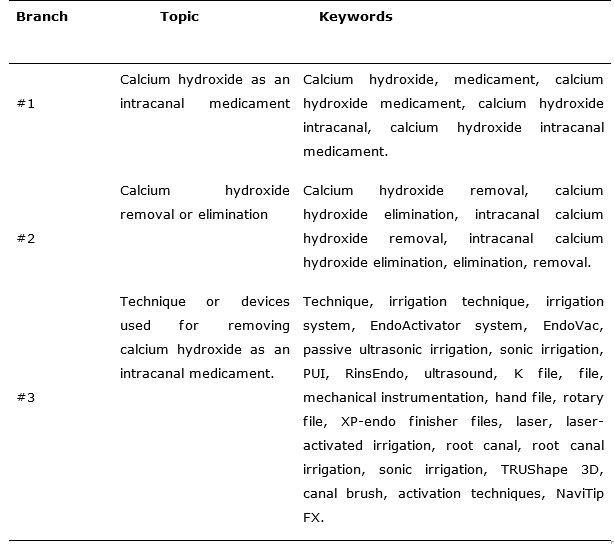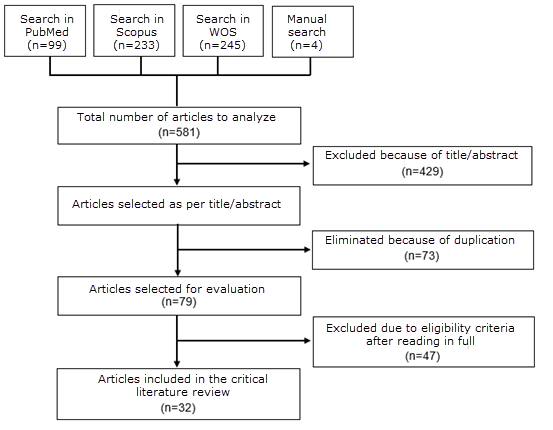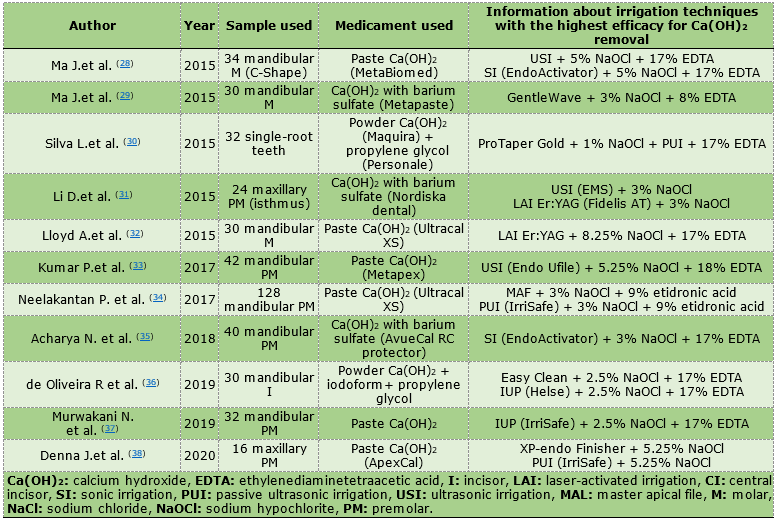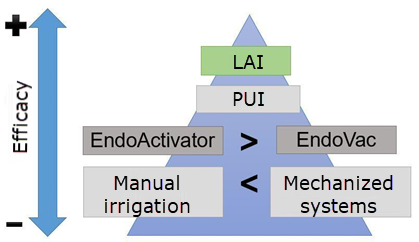Serviços Personalizados
Journal
Artigo
Links relacionados
Compartilhar
Odontoestomatología
versão impressa ISSN 0797-0374versão On-line ISSN 1688-9339
Odontoestomatología vol.24 no.39 Montevideo jun. 2022 Epub 01-Jun-2022
https://doi.org/10.22592/ode2022n39e313
Update
Efficacy of irrigation techniques in removing calcium hydroxide: a literature review
1Facultad de Odontología, Universidad de Valparaíso, Chile. fernandairiarteg@gmail.com
2Cátedra de Endodoncia, Facultad de Odontología, Universidad de Valparaíso, Chile.
Objective:
To conduct a literature review on and describe the most effective irrigation techniques in removing calcium hydroxide as an intracanal medicament.
Materials and methods:
Literature review conducted in PubMed, Scopus, and Web of Science. Thirty-two articles published between 2015 and 2020 were selected.
Results:
Ultrasonic irrigation—the most widely studied technique—does not achieve the highest levels of efficacy. Laser-activated irrigation was the most effective way to remove medication in the three thirds of the canals. The most frequently used irrigants were sodium hypochlorite and ethylenediaminetetraacetic acid.
Conclusion:
The most effective techniques are laser-activated irrigation and passive ultrasonic irrigation. The evidence indicates that sodium hypochlorite and ethylenediaminetetraacetic acid should be used sequentially and not exclusively as irrigants.
Keywords: endodontics; techniques; efficacy; therapeutic irrigation; removal; calcium hydroxide
Objetivo:
Caracterizar en base a una revisión bibliográfica las técnicas de irrigación con mayor eficacia en la remoción de hidróxido de calcio como medicación intraconducto.
Materiales y métodos:
Revisión bibliográfica realizada en las bases de datos electrónicas PubMed, Scopus y Web of Science. Se seleccionaron 32 artículos contenidos entre los años 2015 y 2020.
Resultados:
La técnica más estudiada es la irrigación ultrasónica, no logrando tener los niveles más altos de eficacia. La irrigación activada por láser resultó ser la más eficaz en la remoción de medicación en los tres tercios de los conductos. Los irrigantes utilizados con mayor frecuencia fueron el hipoclorito de sodio y el ácido etilendiaminotetraacético.
Conclusión:
Las técnicas con mayor eficacia son irrigación activada por láser, seguida de irrigación ultrasónica pasiva. La evidencia sustenta que hipoclorito de sodio y ácido etilendiaminotetraacético deben ser los irrigantes utilizados, ambos de manera secuencial y no de uso excluyente.
Palabras claves: endodoncia; técnicas; eficacia; irrigación terapéutica; remoción; hidróxido de calcio
Objetivo:
Caracterizar, com base em revisão bibliográfica, as técnicas de irrigação com maior eficiência na remoção do hidróxido de cálcio como medicamento intracanal.
Materiais e métodos:
Revisão bibliográfica realizada nas bases de dados eletrônicas PubMed, Scopus e Web of Science. Foram selecionados 32 artigos contidos entre os anos de 2015 e 2020.
Resultados:
A técnica mais estudada é a irrigação ultrassônica, não alcançando os níveis mais altos de eficácia. A irrigação ativada por laser foi considerada a mais eficaz na remoção de medicamentos em três terços dos canais. Os irrigantes usados com mais frequência foram hipoclorito de sódio e ácido etilenodiaminotetracético.
Conclusão:
As técnicas mais eficazes são a irrigação ativada por laser, seguida da irrigação ultrassônica passiva. A evidência apóia que o hipoclorito de sódio e o ácido etilenodiaminotetracético devem ser os irrigantes usados, tanto sequencialmente quanto não exclusivamente.
Palavras-chave: endodontia; técnicas; eficácia; irrigação terapêutica; remoção; hidróxido de cálcio
Introduction
The presence of microorganisms in the root canal system (RCS) is crucial for developing pulp and periapical pathologies. Therefore, eliminating microorganisms is one of the main objectives of endodontic therapy.1,2 To this end, mechanical instrumentation is necessary, followed by irrigation and intracanal medicaments. Calcium hydroxide (Ca(OH)2) is one of the most widely used intracanal medicaments due to its antimicrobial and biological action, ability to dissolve organic tissues, anti-inflammatory effects, and osteoclastic inhibition. It also enhances tissue repair.3 However, residual Ca(OH)2 in root canals significantly affects bond strength and dentin resistance. It also hinders the penetration of endodontic sealants into the dentin tubules, increasing the possibility of apical microleakage.4,5
In this regard, several methods have been introduced to increase removal efficacy in the RCS: conventional irrigation, mechanized irrigation, sonic irrigation (SI), ultrasonic irrigation (USI), passive ultrasonic irrigation (PUI), negative pressure irrigation (NPI), and laser-activated irrigation (LAI).6 Clinically, the technique most commonly used to remove the drug is conventional irrigation with syringes, needles of various diameters, and master apical files (MAF) in combination with irrigation solutions, such as sodium hypochlorite (NaOCl) and ethylenediaminetetraacetic acid (EDTA). However, EndoVac (NPI), EndoActivator (SI), PUI, or LAI have shown greater efficacy in removing Ca(OH)2 with statistically significant differences.7
However, the available evidence shows controversy among the published results, as their presentations vary, and there are differences in the structuring and execution of the irrigation techniques. Therefore, there is no evidence grouping the great diversity of methods available according to their types and the characteristics of the most effective removal techniques. The most effective strategy should be the one that removes the greatest amount of intracanal Ca(OH)2.
Therefore, this study aims to conduct a literature review to describe the most effective irrigation techniques in removing Ca(OH)2 as an intracanal medicament. We evaluated the sample type, type of Ca(OH)2, irrigants used, and type of device or instruments used in the most effective techniques.
Materials and methods
The literature review was conducted between October and November 2020 in electronic databases PubMed, Scopus, and Web of Science (WOS). Before the search, branches were structured according to the topic addressed and used to structure the search keys (Table 1).
In addition, a manual search was performed by evaluating similar references in each database during the keyword search. This QR code includes details of the searches in each database and the corresponding keywords (figure 1).
The researchers simultaneously analyzed and preselected the studies after reading their titles and abstracts. Then, each article was read in full. The eligibility criteria for the analysis, selection, and exclusion process were as follows:
Inclusion criteria:
- Experimental in vitro studies in English and Spanish published between 2015 and 2020.
- Use of Ca(OH)2 as the sole medication.
- Use of at least NaOCl and/or EDTA as irrigating agents.
- Comparison of at least two irrigation techniques for Ca(OH)2 removal.
- Studies that used permanent human teeth with a closed apex and artificial grooves in the main root canal.
Exclusion criteria:
- Systematic literature reviews with or without meta-analysis.
- Studies that use temporary teeth, endodontic acrylic cubes simulating root anatomy, or permanent human teeth with interventions that seek to recreate root immaturity or root pathologies, such as rhizolysis.
The study variables to be analyzed in the articles were author, year of publication, the sample used, type of Ca(OH)2, irrigants used, and the technique(s) with the greatest efficacy in Ca(OH)2 removal.
Results
A total of 581 articles were obtained from the search, of which 32 articles were selected according to the eligibility criteria and the analysis conducted by the researchers: 32 in English and 1 in Spanish (Figure 2).
Evaluation of residual Ca(OH)2 in artificial canal grooves
We analyzed nine studies where artificial grooves were made in the main canal to simulate retention areas (Table 2). Approximately 55.5% of the authors conclude that PUI is the most effective option for Ca(OH)2 removal, followed by LAI with 33% and USI with 22.2%.
Evaluation of residual Ca(OH)2 using microscopy or chemical titration
We evaluated 12 studies where residual medicament was analyzed using microscopy or chemical titration (Table 3). A total of 33.3% of the studies showed that SI is the most effective option for Ca(OH)2 removal, followed by PUI with 25% and NPI with 16.6%.
Evaluation of residual Ca(OH)2 through imaging studies
We analyzed 11 studies where residual medicament was evaluated using imaging technology, 73% of which were assessed with Computed Microtomography (MicroCT) (Table 4). Approximately 36.3% of the studies indicated that PUI is the most effective Ca(OH)2 removal method, followed by USI with 27.2% and LAI with 18%.
NaOCl and EDTA were the most commonly used irrigation solutions in the 32 studies analyzed to establish Ca(OH)2 removal efficacy, with a relative frequency of 93.75% and 68.75%, respectively. Etidronic acid was used less frequently (6.25%). Other studies used Qmix 2in1 (EDTA and CHX, Dentsply), peracetic acid, and Savlon ™ (CHX and Cetramide) at a 3.13% concentration.
Table 2: Experimental in vitro studies on the efficacy of Ca(OH)2 removal techniques in canals with artificial grooves
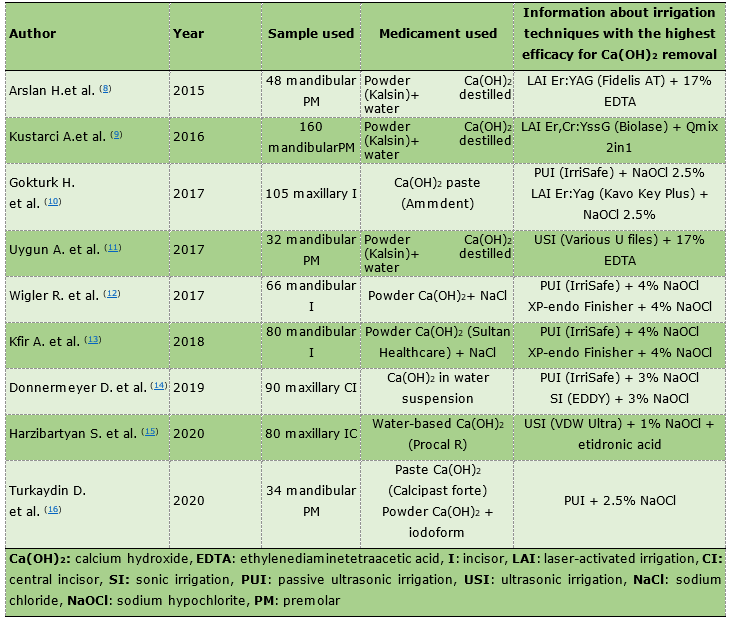
Table 3: Experimental in vitro studies on the efficacy of various techniques in removing Ca(OH)2 from canals that evaluate residual medicament using microscopy or chemical titration
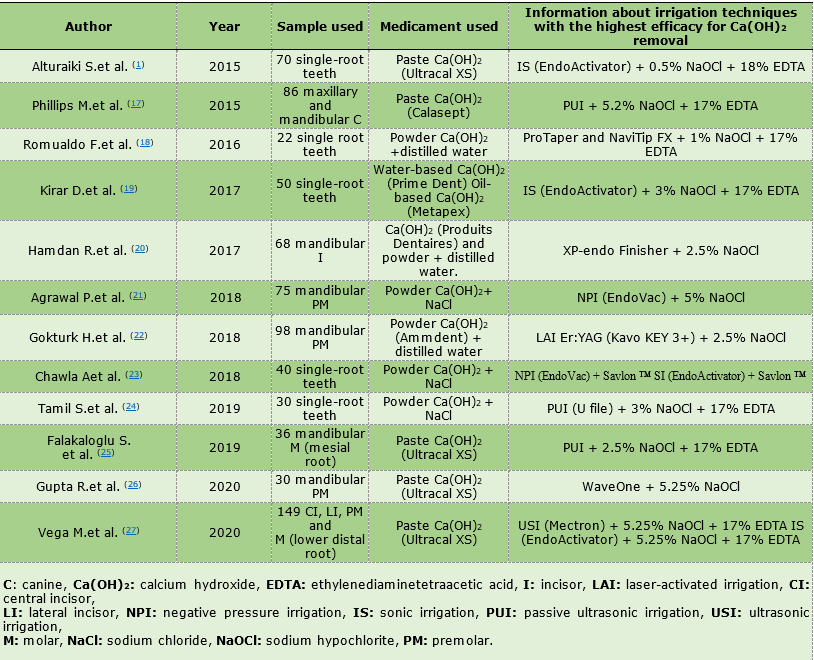
Discussion
The most effective techniques require a minimum activation time of one minute for each irrigant, and the most used and recommended irrigation solutions are NaOCl and EDTA.39 PUI and LAI have proven to be the most effective techniques in removing Ca(OH)2. However, the EndoVac device, categorized as NPI, proved to be the most effective in removing residual medicament in the apical third.40
Various irrigants have been used for medication removal. The combined use of NaOCl and 17% EDTA is ineffective for full Ca(OH)2 removal. However, this combination proves to be more effective in removing the medicament than the agents used separately.41 The efficacy of other calcium chelators such as 10% citric acid and 7% maleic acid has been studied. It is suggested that their use would be effective in removing Ca(OH)2 from root canals.42 It has been shown that 30 seconds of irrigation is ineffective for complete Ca(OH)2 removal. Uzunoglu et al.43 suggest an irrigation time of approximately one minute for each irrigant used, regardless of the irrigation technique. Furthermore, efficacy is directly related to the volume of irrigant used, i.e., the greater the volume of irrigant, the greater the efficacy of irrigation.44
Of the publications analyzed, 37.5% studied PUI, making it one of the most effective options. Li et al. 31 observed that PUI was the most effective method for removing this medicament in the three thirds of the root canal compared to conventional irrigation. No significant differences were found between this type of activation and XP-endo Finisher in the coronal and middle thirds. Although the difference in the amount of irrigant extrusion outside the apex is minimal between SI and PUI, it is still higher in PUI.45 This is explained by the difference between the powers at which acoustic currents and cavitations are generated, as they are higher in PUI.46 Although LAI is the least studied technique, it has been shown to leave almost 0% residual Ca(OH)2.32
Sonic irrigation showed favorable results because this type of energy requires vigorous irrigant agitation in the canals through oscillatory movement and bubble cavitation.46 Alturaiki et al. 1 found that EndoActivator was highly effective in removing medicament at the coronal, middle, and apical thirds of the canals compared to other techniques such as USI and NPI. However, NPI proved to be more effective at the apical third than SI because of the microcannula specially designed for this area.47 A potential disadvantage of this system is the blockage of the microcannula orifices, which may contribute to failed Ca(OH)2 removal. EndoVac has presented significant differences when removing residual medicament. The working length (WL), less than 1 mm, is considerably less than irrigation performed at 2 mm, under this system or another, such as conventional needle irrigation.1
It is necessary to rigorously consider the working length and the caliber of the apical conformation for appropriate biomechanical preparation. This guarantees case resolution and the integrity of the surrounding tissues. An extruded irrigation solution can cause inflammation and, in some cases, even tissue necrosis, resulting in severe perioperative and postoperative pain. In addition, this may compromise the healing of apical periodontitis.48
The studies analyzed showed significant variability in the use or non-use of radiopaque Ca(OH)2, which challenges the correct assessment of the residual medicament. Therefore, radiopaque Ca(OH)2 should be used to distinguish between medication and a smear layer and to evaluate and assess the case through imaging accurately. Furthermore, future studies should include sample units with more significant anatomical variability as this would be closer to applying these techniques in vivo. Similarly, further research should be conducted on the efficacy of GentleWave and Easy Clean devices, as they showed promising efficacy in Ca(OH)2 removal, though the evidence is currently limited.
Only in vitro experimental studies were conducted. We observed significant variability in the execution of irrigation techniques and presentation of the results by the authors, which makes it difficult to standardize systematic reviews with or without meta-analysis. Therefore, standardizing this type of research will provide a higher level of evidence to support clinical decision making.
Finally, the least effective technique is manual irrigation because there is no aid to the continuous delivery of the irrigant.31 On the other hand, irrigation associated with mechanized systems is more effective due to the physical contact between the rotary instrument and the root canal walls. Furthermore, the EndoActivator system has a better hydrodynamic mechanism than EndoVac, allowing the irrigant to penetrate, circulate, and flow in the hard-to-reach areas of the RCS.40 Passive ultrasonic irrigation had one of the best results. It is recommended because its activation is not interrupted. However, LAI was the most effective technique due to the emission of photons that create photoacoustic shock waves in the irrigant and, therefore, effectively cleans the root canals (Figure 3).
Conclusions
The literature review shows that the best irrigant activation options to remove more residual Ca(OH)2 in the three thirds of root canals are LAI and PUI. This proves that the most studied technique is not the most effective one. In addition, the irrigants used in each irrigation technique should be NaOCl and EDTA, sequentially and not exclusively, considering a minimum irrigant activation time of one minute.
Finally, a successful technique involves the combined use of several devices. Clinicians should identify the potential of each one of them in the three root segments, weighing the clinical variability that each case may have.
REFERENCES
1. Ganss C. Definition of erosion and links to tooth wear. Monogr Oral Sci. 2006;20: 9-16. [ Links ]
2. Murakami C, Oliveira LB, Sheiham A, Nahas Pires Correa MS, Haddad A. E, Bönecker M. Risk Indicators for Erosive Tooth Wear in Brazilian Preschool Children. Caries Res. 2011; 45(2)121-129. [ Links ]
3. Ranjitkar S, Smales RJ, Kaidonis JA. Oral manifestations of gastroesophageal reflux disease. Journal of Gastroenterology and Hepatology. 2012;27(1)21-27. [ Links ]
4. Murakami C, Tello G, Abanto J, Oliveira LB, Bonini GC, Bönecker M. Trends in the prevalence of erosive tooth wear in Brazilian preschool children. Int J of Paed Dent. 2016;26(1):60-5. [ Links ]
5. Schlueter N, Jaeggi T, Lussi A. Is Dental Erosion Really a Problem? Adv Dent Res. 2012;24(2):68-71. [ Links ]
6. Kreulen CM, Van´t Spijker A, Rodriguez JM, Bronkhorst EM, Creugers NHJ Bartlett DW. Systematic review of the prevalence of tooth wear in children and adolescents. Caries Res. 2010; 44:151-9. [ Links ]
7. Luo Y, Zeng XJ, Du MQ, Bedi R. The prevalence of dental erosion in preschool children in China. J Dent. 2005; 33:115-121. [ Links ]
31. Li D, Jiang S, Yin X, Chang JW, Ke J, Zhang C. Efficacy of Needle, Ultrasonic, and Endoactivator Irrigation and Photon-Induced Photoacoustic Streaming in Removing Calcium Hydroxide from the Main Canal and Isthmus: An In Vitro Micro-Computed Tomography and Scanning Electron Microscopy Study. Photomed Laser Surg. 2015 Jun;33(6):330-7 [ Links ]
32. Lloyd A, Navarrete G, Marchesan MA, Clement D. Removal of calcium hydroxide from Weine Type II systems using photon-induced photoacoustic streaming, passive ultrasonic, and needle irrigation: a microcomputed tomography study. J Appl Oral Sci. 2016 Nov-Dec;24(6):543-48. [ Links ]
39. Masudi S, Azhar L, Raja R, Khursheed M. Removal Efficiency of Calcium Hydroxide Intracanal Medicament Using Two Irrigation Solutions. Int Medical J. 2014 Feb; 21(1): 106-9 [ Links ]
40. Parikh M, Kishan K, Solanki N, Parikh M, Savaliya K, Bindu VH, et al. Efficacy of removal of calcium hydroxide medicament from root canals by endoactivator and endovac irrigation techniques: A Systematic review of in vitro studies. Contemp Clin Dent. 2019;10:135-42 [ Links ]
41. Murwakani NS, Usman M, Djauharie RAHN, Marissa C. Comparison of sonic and ultrasonic activation for removal of calcium hydroxide from root canals - A micro-CT study. J. int. dent. med. res. 2019 Jan;12(1):123-128 [ Links ]
42. Raghu R, Pradeep G, Shetty A, Gautham P, Puneetha P, Satyanarayana TV. Retrievability of calcium hydroxide intracanal medicament with three calcium chelators, ethylenediaminetetraacetic acid, citric acid and chitosan from root canals: an in vitro cone beam computed tomography volumetric analysis. J Conserv Dent. 2017 Jan-Feb; 20(1): 25-29 [ Links ]
43. Uzunoglu E, Eymirli A, Uyanik MÖ, Çalt S, Nagas E. Calcium hydroxide dressing residues after different removal techniques affect the accuracy of root-ZX apex locator. Restor Dent Endod. 2015 Feb;40(1):44-9 [ Links ]
44. Ahmetoglu F, Keles A, Simsek N. Effectiveness of the several irrigation techniques for removal of calcium hydroxide‐based intracanal medication from an artificial standardized groove in the apical root canal. Marmara Dent J. 2013 Jan;2: 53-6 [ Links ]
45. Azim AA, Aksel H, Margaret Jefferson M, Huang GT. Comparison of sodium hypochlorite extrusion by five irrigation systems using an artificial root socket model and a quantitative chemical method. Clin Oral Investig. 2018 Mar;22(2):1055-1061 [ Links ]
46. Vangala A, Doshi SR, Aparadh A, Hegde V. Apical Extrusion of Sodium Hypochlorite using Various Mechanical Activators. World J Dent. 2016;7(3):146-49 [ Links ]
47. Ahamed AA, Raj JD. Negative pressure irrigation system: a review. J. Pharm. Res. 2019 Jun;13(1):8-14 [ Links ]
48. Laky M, Volmer M, Arslan M, Agis H, Moritz A, Cvikl B. Efficacy and Safety of Photon Induced Photoacoustic Streaming for Removal of Calcium Hydroxide in Endodontic Treatment. Biomed Res. Int. 2018 Apr:1-6 [ Links ]
2Authorship contribution: 1. Conception and design of study 2. Acquisition of data 3. Data analysis 4. Discussion of results 5. Drafting of the manuscript 6. Approval of the final version of the manuscript GG has contributed in 1, 2, 3, 4, 5, 6. MI has contributed in 1, 2, 3, 4, 5, 6. PA has contributed in 1, 4, 5, 6.
Received: August 06, 2021; Accepted: December 12, 2021











 texto em
texto em 


